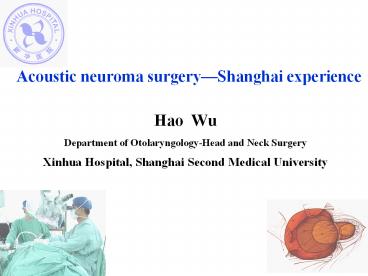Acoustic neuroma surgery - PowerPoint PPT Presentation
1 / 43
Title:
Acoustic neuroma surgery
Description:
Acoustic neuroma surgery Shanghai experience Hao Wu Department of Otolaryngology-Head and Neck Surgery Xinhua Hospital, Shanghai Second Medical University – PowerPoint PPT presentation
Number of Views:325
Avg rating:3.0/5.0
Title: Acoustic neuroma surgery
1
Acoustic neuroma surgeryShanghai experience
- Hao Wu
- Department of Otolaryngology-Head and Neck
Surgery - Xinhua Hospital, Shanghai Second Medical
University
2
- McBumey (1891) unsuccessful
- Balance (1894) first successful
3
- Cushing Era
- Surgical mortality 80
- Cushing partial removal
4
- Dandy Era(19171961)
- Total removal mortality?(22.1)
- Atkinson (1949) AICA
- Total facial paralysis
5
- 1960
- Mortality rate in California 43.5
- Olivecrona (Sweden)414 cases
- small tumors 4.5
- large tumors 22.5
- Facial paralysis 50
6
- Dr. W. House (1961-)
- Middle fossa approach (1961)
- Traslab approach (1962)
7
Origin
- Development in the internal acoustic meatus from
the schwann cells of the vestibular ganglion
(Sterkers JM et al., Acta Otolaryngol., 1987) - Arachnoid sheet enveloping the tumour during its
expansion to the CPA.
8
Epidemiology
- 6 to 8 of all intracranial tumours
- The most frequent (80 to 90) of the CPA tumours
- Sporadic, and solitary in 95 of cases
- Associated with NF2 in 5 of cases
- Estimated incidence in USA and Western Europe 1
for 100,000 individuals per year (Kurlan et al.,
J neurosurg, 1958 Nestor JJ et al., Arch
Otlaryngol Head Neck Surg, 1988)
9
REASON FOR CONSULTATION
Moffat et al., 1998 n 473
.
Expected symptom 80.7 (progressive
HL,tinnitus,unsteadiness) Sudden hearing
loss 9.6 Atypical presentation 10
.
.
10
MRI diagnosis
- Isosignal on T1, and variable aspect en T2 views
- Constant gadolinium enhancement
- Intratumoral cysts in large neurinomes
- No adjascent meningeal enhancement
- Enlarged IAM
- Extension predominantly posterior to IAM
11
Differential diagnosis
- Other neurinomas in the CPA 5th, 7th, or caudal
cranial nerve neurinomas - Other lesions
- Most frequent
- Meningiomas
- Cholesteatomas
- Rare lesions lipomas, metastases, hemangiomas,
medulloblastomas etc..
12
Unilateral or asymetrical audio-vestibular signs
Hearing loss, vestibular syndrome, tinnitus
13
Decisionnal factors
- Tumor volume
- Age
- Hearing function
14
Therapeutic options
Varaiable tumor growth According to age and
tumor size lt 1,5 cm MRI in 6 months and then
once a year
- Conservative managament
- Radiotherapy
Gamma-knife, LINAC Volume stabilisation Hearing
loss and facial paresis Under evaluation
- Surgery
15
Goals of the surgery
- 1- Minimal vital and neurological risks
- 2- Total removal
- 3- Facial function preservation
- 4- Hearing preservation
16
Approaches
17
Acoustic Neuromas
Intracanalar or CPA lt 20 mm
lt 70 years Surgery
Poor general condition Irradiation
gt 70 years Conservative management
Hearing
Serviceable
Unserviceable
18
Population
- 1999.1-2004.3 100 VS operated on
- Mean age 49 years (range 20-79)
- Sex ratio 0.8
- Tumor stages
- Stage 1 3
- Stage 2 11
- Stage 3 71
- Stage 4 15
19
Approaches
- Translabyrinthine 77
- Transotic 6
- Retrosigmoid 12
- Middle cranial fossa 5
- 17 attempt to hearing preservation
20
ABR
Intraoperative monitoring
21
Direct cochlear nerve potential
22
Resection quality
- Complete removal in 98 cases
- Subtotal removal in 1 cases (1 )
- In cases with subtotal removal
- 1 MRI images demonstrate to be stable (1 )
- 1 case surgically revised (1 )
23
Postoperative facial function in
translabyrinthine or transotic approach
Stages Cases Facial function 1 2 3 4 5 6
?? 83 31 15 13 12 8 4
24
Hearing preservation
- Hearing preservation attempts by middle cranial
fossa or retrosigmoid approach (n17)
Class C 24
Class D 40
Class B 24
Class A 12
Class AB 36
25
Complications
- CSF leaks 6(all in first 39 cases)
- Neurological 3
- Infectious 1
- Miscellaneous 3
26
Translabyrinthine approach
27
Translabyrinthine removal of VS after radiosurgery
- 5 cases
- Difficult in facial nerve dissection
- Resultstotal removal in all cases
- facial function grade II in 1
case - grade
III in 2 cases - grade
IV in 2 cases - grade
VI in 1 case
28
Transotic removal of VS with chronic middle ear
infection
- 3 cases
- Resultstotal removal in all cases
- facial function all with
gradeI-II - no postoperative infection
29
Fallopian bridge technique
30
Middle fossa approach
31
(No Transcript)
32
Retrosigmoid-IAM approach
33
Facial nerve repair after interruption
- end-to-ent anastomosis
- Reroute technique
- Bridge technique
- Facial-hypolingual ana.
34
Hearing rehabilitation in acoustic neuroma surgery
- NF2 and Auditory Brainstem Implant
35
NF2 DIAGNOSIS
- Bilateral vestibular schwannoma (VS)
- NF2 familial history
- and
- - unilateral VS
- - or 2 among meningioma, glioma,
neurofibroma,schwannoma,subcapsular lens
opacity
36
NF2
- NF2 gene on chromosome 22 (1993)
- Tumor suppressor gene
37
Auditory pathway
38
Nucleus 21 Channel Auditory Brainstem Implant
Removeable magnet
CI22M receiver-stimulator
Monopolar reference electrode (plate)
Microcoiled electrode wires
T-shaped Dacron mesh
Electrode array (21 platinum disks 0.7mm diameter)
39
(No Transcript)
40
Bone anchored hearing aide (BAHA)
- Single sided deafness
- FDA approval
41
Conclusions 1
- In spite of modern image techniques, large VS
acounts for most diagnosed cases in China. - The translabyrinthine app. could be used in even
largest VS with minival invasion.
42
Conclusions 2
- The facial function is aceptable in most
patients. - The hearing preservation result should still be
improved. - Hearing rehabilitation techniques are available
after tumor removal.
43
Thanks































